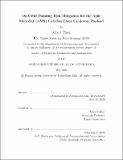| dc.contributor.advisor | Cahoy, Kerri | |
| dc.contributor.author | Thieu, Albert | |
| dc.date.accessioned | 2022-08-29T16:29:37Z | |
| dc.date.available | 2022-08-29T16:29:37Z | |
| dc.date.issued | 2022-05 | |
| dc.date.submitted | 2022-06-09T16:15:03.585Z | |
| dc.identifier.uri | https://hdl.handle.net/1721.1/145050 | |
| dc.description.abstract | The AMS Beacon is a ½-U laser guidestar payload, scheduled to launch in April 2022 aboard the Agile MicroSat (AMS) 6-U CubeSat. The payload carries a laser with a wavelength of 976 nm and a power of up to 500 mW. The AMS Beacon will be the first to provide an active lasing low Earth orbit reference for high-angle rate adaptive optics (AO). During the science phase of the mission, it will establish a space-to-ground link with an AO-equipped ground station. Due to budget constraints and size, weight, and power (SWaP) limitations, the AMS Beacon was designed without gimbals or fast-steering mirrors, to utilize only open-loop body-pointing and generic CubeSat attitude control software. This thesis presents the pre-launch work, the radiometric link analysis, and a novel on-orbit scanning procedure to reduce mission risk due to a static pointing error and if necessary, recover and recharacterize the orientation of the laser beam relative to the spacecraft body. Within the limits of the attitude determination and control system (ADCS), our search mode can accommodate over 1.75° of pointing error during a single pass, and has the capability to search larger areas by concatenating data from multiple successive passes. As our expected pointing error is approximately 0.1°, this search mode is a fail-safe in case of larger than expected pointing shifts during launch and deployment. The recharacterization scan can also re-determine the beam orientation to within 0.1°. Our scheme utilizes AMS’s body-pointing capability, AMS telemetry, and ground-based radiometric readings to recover and re-characterize beam alignment knowledge on-orbit. We simulate these data sources using the AMS flatsat and our link model. We then validate our on-orbit scanning procedure and analysis pipeline for recharacterizing the beam orientation. Because this procedure relies on standard CubeSat pointing capabilities and telemetry, we believe that our procedure could be used for future laser guidestar CubeSat payloads. | |
| dc.publisher | Massachusetts Institute of Technology | |
| dc.rights | In Copyright - Educational Use Permitted | |
| dc.rights | Copyright MIT | |
| dc.rights.uri | http://rightsstatements.org/page/InC-EDU/1.0/ | |
| dc.title | On-Orbit Pointing Risk Mitigation for the Agile MicroSat (AMS) CubeSat Laser Guidestar Payload | |
| dc.type | Thesis | |
| dc.description.degree | S.M. | |
| dc.contributor.department | Massachusetts Institute of Technology. Department of Aeronautics and Astronautics | |
| dc.identifier.orcid | https://orcid.org/0000-0002-5489-6928 | |
| mit.thesis.degree | Master | |
| thesis.degree.name | Master of Science in Aeronautics and Astronautics | |
